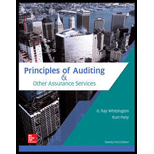
Charles Worthington, the founding and senior partner of a successful and respected public accounting firm, was a highly competent practitioner who always emphasized high professional standards. One of the policies of the firm was that all reports by members or staff be submitted to Worthington for review.
Recently, Robert Craft, a junior partner in the firm, received a phone call from Herbert Flack, a close personal friend. Flack informed Craft that he, his family, and some friends were planning to create a corporation to engage in various land development ventures; that various members of the family are presently in a
Flack asked Craft to prepare a
The transmittal letter stated: “We have reviewed the books and records of Flack Ventures, a partnership, and have prepared the attached balance sheet at March 31, 20X0. We did not perform an audit in conformity with generally accepted auditing standards, and therefore do not express an opinion on the accompanying balance sheet.” The balance sheet was prominently marked “unaudited.” Craft signed the letter and instructed his secretary to send it to Flack.
Required:
What legal problems are suggested by these facts? Explain.
Want to see the full answer?
Check out a sample textbook solution
Chapter 4 Solutions
Principles Of Auditing & Other Assurance Services
- Calculate Windsor Gear works total assets on these financial accounting questionarrow_forwardBeta Corporation began operations on January 1 with cash of $100,000. All of January's $200,000 sales were on account. During January, no customer collections occurred. The cost of goods sold was $70,000, and there were no ending inventories or accounts payable. Use this information to determine the ending balance of cash on hand for January.arrow_forwardNeed help with this financial accounting questionarrow_forward
 Cornerstones of Cost Management (Cornerstones Ser...AccountingISBN:9781305970663Author:Don R. Hansen, Maryanne M. MowenPublisher:Cengage Learning
Cornerstones of Cost Management (Cornerstones Ser...AccountingISBN:9781305970663Author:Don R. Hansen, Maryanne M. MowenPublisher:Cengage Learning
